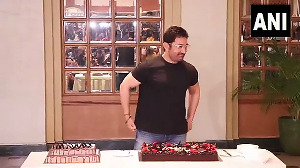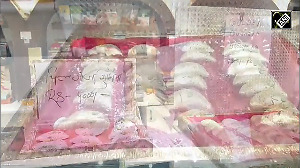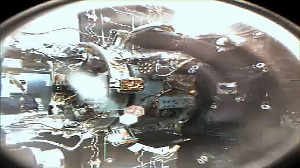Dr Rajiv Shah, administrator of the United States Agency for International Development and the highest ranking Indian American in the Obama administration, who accompanied US President Barack Obama to India said that today his agency's developmental relationship with India has evolved into a peer to peer partnership unlike in the past when India was simply an aid recipient.
Shah, who was at the Foreign Press Center to review the President's trip, asked by rediff.com what would be USAID's agenda going forward with regard to India, considering its own budget constraints and since Obama himself had declared that India was not just emerging but had emerged, and the fact that India was today an aid donor and there were rumblings in the international community that India no longer should be an aid recipient --particularly massive World Bank largesse -- said what Obama and First Lady Michelle Obama did on this trip was "consistent," with the new agenda of USAID vis-à-vis India.
"Our development relationship has already evolved and will continue to evolve tremendously from a traditional partnership where a donor provides resources and technical expertise to really a peer to peer partnership," he said.
Shah said, today it was a case of "where we explore real technical cooperation and look for those opportunities where Indian innovators and scientists and entrepreneurs can create solutions that apply all around the world."
"One great example," he pointed out," is that we had the chance as part of the Ag-Expo to see micro-irrigation systems that were solar-powered, where solar panels came from a manufacturer in Atlanta and the rest of the system was entirely PVC piping based -- very, very low cost application so that it would have broad applicability through rural India."
Shah said, "Now, we are working with those partners to take those systems to Africa as well, where food security remains a tremendous concern and this is going to be a big part of the solution."
"So the first thing is this shift to real technical cooperation and instead of thinking that it is a traditional development partnership, looking at how we can work together to solve global problems," he added.
Shah said, "The second one is that we really are working in greater partnership with the India government and they have asked us to focus in certain parts of the country and on certain issues like certain diseases and on certain states and so we are reshaping our programs to align against that request."
He said that "the President's speech to Parliament, really captured the full breadth and nature of our shared histories and our aspirations going forward, and while that served as a venue to announce some of these development oriented efforts, it's really the broader framework that is the message that is important."
"That this is now a partnership with two countries standing together as peers capable of addressing the challenges that the world faces today," he reiterated.
Shah also said that while of course much of the reports of the trip was permeated by the high profile big ticket items like the President's endorsement of US support for India's bid for a permanent seat in the United Nations Security Council, this was also an opportunity for Obama to launch a "modern version" of the Green Revolution of the 1960s and 1970s launched by Nobel laureate Normal Borlaug.
He said that "both the President and the Prime Minister for more than a year now of dialogue had committed to expanding our partnership in agriculture in particular and President Obama and Prime Minister Singh announced on this trip a major new partnership geared at agricultural development, which was titled The Partnership for an Evergreen Revolution."
Shah recalled that "the United States has a very rich history working with India to improve its agriculture and food security -- in fact in the 1960s and 1970s, US investment and technical partnership led to the creations of an agricultural university system in India and the introduction of both crops and fertilizers to help a country where tens of millions, probably hundreds of millions of people were facing starvation, become a net exporter of good and significantly improve its own food security."
He said that along with the President and Agriculture Secretary Tom Vilsack, they had met with technology entrepreneurs and social entrepreneurs and leaders in the agriculture field in India who were "creating really unique solutions for a rural India, whether it was technology enabled extension services, people who were creating farmer to farmer You Tube systems that would allow farmers to tape messages and then have their neighbors essentially hear what the were doing to deal with drought or changing climate conditions or whatever the challenge of the time was."
Shah also spoke of how along with the President, they had met with "university leaders in India who are partnering between Punjab Agriculture University and US agriculture universities to expand these partnerships and really had the opportunity to launch a very specific program."
He said this program would "focus on joint agricultural research, joint investments in agricultural extension and efforts to reach some of the poorest of the poor in rural parts of India and marketing efforts so that farmers can get their crops to market in a more effective way."
Shah said that both the President and the First Lady had "made a personal commitment to make sure that they were connecting with all aspects of India society in India's population."
Thus, he said, "They, through their own example, motivated millions of people who of course, saw them in those roles. So, that was very much the intention of this visit, which was to really connect with the Indian people broadly and recognise and honour so many different parts of the Indian experience."









 © 2025
© 2025